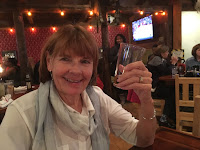Fredericksburg, an amazing little town in Virginia, took us completely by surprise. We started out day after breakfast at the battlefield Visitors Center and learned much more than we ever knew about the great battles of the Civil War that were fought in this area. Over 100,000 Americans lost the lives in the many battlegrounds in and around Fredericksburg. And many of those
 |
| Fredericksburg National Cemetery |
lives were lost by the stupidity of a Rhode Islander, Ambrose Burnside of Bristol. Burnside stupidly ordered his men to cross the Rappahannock River under heavy fire and many many lives were lost in that attempt, which failed. . .so he tried again. He attained the nick name of "The butcher of Fredericksburg" not because he killed so many of the enemy but because he lost so many of his own troops. Next to the Visitor Center is Fredericksburg National Cemetery which is the final resting place for more than 15,000 Union Troops, the majority
 |
| A fallen Rhode Islander |
of whom have never been identified. Those that were never identified have only
 |
| Walking the cemetery |
a numbered marker above their grave and most of these marked graves have multiple bodies beneath the stone. Carol and I walked the cemetery and found graves of those from NY, CT, MA, VT, and RI and so many that were unknown. We had watched the movie in the visitor center which had a reenactment of the battle which made our hearts black with pain to think of so many deaths on this soil. What a terrible time in our history. From the cemetery we took a
 |
| Sunken Road |
short walk down the Sunken Road where the Confederate infantry had their men in place for the battle, behind a stone wall looking out over the advancing Union troops coming across an open field, It was all quite sobering. Then we discovered something quite surprising about Fredericksburg..this is where George Washington grew up. The Washington family was from Fredericksburg. We visited very
 |
| Georges's Brothers Place |
briefly (drove in drove out) the family farm which was closed for renovations - a big disappointment. We did a bit of a walking tour of the town and found The Rising Sun Tavern. We had a great tour of the Tavern by a young lady who is a period re-enactor and stayed in character through out the tour. It was hard times back then, I no longer wish for 'the good old days'. Times were hard and this was certainly no time in our history for the ladies. Today is better, yep, today is better. We wandered down the street a bit further and came to the Lewis Store, another 18th century place of business that is being restored. It was in this building that the young George
 |
| Lewis Store |
Washington would come and purchase things after school before he caught the ferry back to the other side of the river where the
 |
| Typical Civil War era house |
farm was. From here we walked the town a bit more admiring the buildings and found a neighborhood sandwich shop for lunch. After lunch we drove the Lee Drive, a five mile drive along the Confederate battle lines. The trenches are still visible along the roadside and you can imagine the numbers of men that were here during the battles. Lee
 |
| Cannon along Lee Drive |
had his cannon on the high ground and Stonewall Jackson had his
 |
| Reading |
cannon and troops all along this area as well. We stopped and read
every placard and sign and tried to imagine all that went on here back so long ago. In these times when our country seems to be very divided let us remember the past so we can come together and work toward the common good. Let our country never be so divided again. Here are a few more pictures from the day.
 |
| Walking the cemetery |
 |
| Entrance |
There are so many images that have stuck in my head from today, I wish I could share all of them but maybe some of these shots will help.
 |
| Along the sunken road |
 |
| One last cannon |
From the cemetery to the town and all along Lee Drive we felt like we
 |
| House at the cemetery |
were stepping back into history.
 |
| Episcopal Church |




































